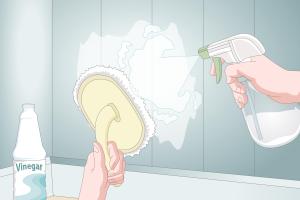Simple DIY Ways to Polish & Restore Plastic So It Shines

-
Quick Links:
- Introduction
- Understanding Plastic Types
- Why Polish and Restore Plastic?
- Tools and Materials Needed
- Step-by-Step Guides
- Case Studies
- Expert Insights
- Safety Tips
- Conclusion
- FAQs
Introduction
Plastic is one of the most versatile materials used in everyday life. From household items to outdoor furniture, plastic products are everywhere. However, over time, plastic can become dull, scratched, and discolored. Fortunately, there are several simple DIY methods to polish and restore plastic, bringing back its original shine and luster. In this comprehensive guide, we will explore various techniques, tools, and materials that make plastic restoration easy and effective.
Understanding Plastic Types
Before diving into restoration techniques, it’s essential to understand the types of plastics you might encounter:
- Polyethylene (PE): Common in bottles and bags.
- Polypropylene (PP): Used in containers and automotive parts.
- Polyvinyl Chloride (PVC): Found in pipes and siding.
- Polystyrene (PS): Common in disposable cutlery and packaging.
- Acrylic (PMMA): Often used as a glass substitute.
Knowing the type of plastic will help you choose the right restoration method.
Why Polish and Restore Plastic?
Polishing and restoring plastic offers several benefits:
- Enhance Aesthetics: Shiny plastic looks new and appealing.
- Increase Lifespan: Proper care can extend the life of plastic items.
- Eco-Friendly Option: Restoration reduces waste by prolonging the use of existing products.
Tools and Materials Needed
To effectively polish and restore plastic, gather the following tools and materials:
- Soft cloths or microfiber towels
- Plastic polish or compound
- Sandpaper (various grits)
- Water and soap solution
- Vinegar or baking soda for cleaning
- Protective gloves
- Masking tape (optional)
Step-by-Step Guides
Method 1: Using Plastic Polish
- Clean the plastic surface with a soapy water solution.
- Dry the surface thoroughly with a soft cloth.
- Apply plastic polish to a clean cloth.
- Rub the polish onto the plastic in circular motions.
- Buff the surface with a clean cloth until shiny.
Method 2: Sanding and Buffing
- Use a fine-grit sandpaper to gently sand the scratched area.
- Wipe away dust with a damp cloth.
- Switch to a higher grit sandpaper and repeat the process.
- Polish with a plastic compound as described above.
Method 3: Household Alternatives
If you prefer eco-friendly options, try these household products:
- Vinegar: Mix with water to clean and shine plastic.
- Baking Soda: Create a paste to buff out scratches.
Apply these mixtures in the same manner as above for effective results.
Case Studies
To illustrate the effectiveness of these methods, consider the following case studies:
Case Study 1: Restoring an Old Toy
In a recent project, an old plastic toy was restored using a combination of vinegar and plastic polish. The results were impressive, with the toy looking brand new after just a few simple steps.
Case Study 2: Outdoor Furniture
Outdoor furniture often suffers from UV damage, leading to a faded appearance. A homeowner used sandpaper followed by a quality plastic polish, resulting in a significant transformation.
Expert Insights
We consulted with home improvement experts for their take on plastic restoration:
"Regular maintenance is key. Simple cleaning can prevent long-term damage to plastic items." - Home Improvement Specialist
Safety Tips
When working with any restoration materials or tools, keep these safety tips in mind:
- Always wear gloves to protect your skin.
- Ensure proper ventilation when using chemical polishes.
- Test any product on a small area first to avoid damage.
Conclusion
Polishing and restoring plastic can breathe new life into your items, making them look vibrant and well-maintained. By following the methods outlined in this article, you can successfully restore plastic surfaces and extend the life of your possessions. Whether you're tackling small household items or larger outdoor furniture, these simple DIY methods are effective and satisfying.
FAQs
1. Can I use car polish on plastic?
Yes, car polish can be used, but ensure it’s suitable for plastic surfaces and test on a small area first.
2. How do I remove scratches from plastic?
Using fine-grit sandpaper followed by plastic polish is an effective method to remove scratches.
3. Is it safe to use vinegar on plastic?
Yes, vinegar is safe and effective for cleaning and restoring plastic.
4. How often should I polish my plastic items?
It depends on usage, but a good rule of thumb is to polish items at least once a year.
5. What is the best way to protect restored plastic?
Keep restored items out of direct sunlight and clean them regularly to maintain shine.
6. Can I use baking soda to clean plastic?
Yes, baking soda is a gentle abrasive that can help clean and polish plastic surfaces.
7. Why does plastic turn yellow?
Plastic can turn yellow due to UV exposure, heat, and age. Regular maintenance can help prevent this.
8. What is the best plastic polish on the market?
Brands like Novus and Meguiar's are popular for effective plastic polishing.
9. How do I clean cloudy plastic?
Use a plastic polish or a mix of vinegar and water, followed by buffing with a soft cloth.
10. Can I restore faded plastic?
Yes, faded plastic can often be restored using polishing techniques and products specifically designed for plastic.
Random Reads
- Mastering word grouping objects
- How to estimate wallpaper needed
- How to open locked bathroom door twist push locks
- How to create character skyrim
- How to script on roblox
- How to scan qr codes on nintendo 3ds
- How to force reboot android phone no power button
- How to clone hard drive windows xp
- How to close a velux window
- Change video format to mp4